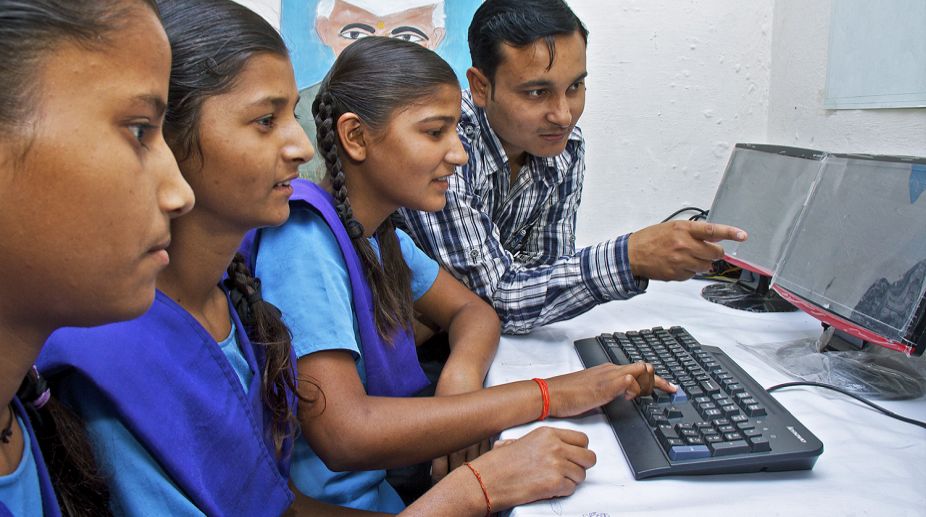Ponting endorses Shubman Gill as India’s new Test Captain
Australian great Ricky Ponting has endorsed Shubman Gill as the right choice to lead India into a new era of Test cricket, following the retirements of stalwarts Virat Kohli and Rohit Sharma.

(Photo: SNS)
Long ago, we had a tryst with destiny and since then India has seen a phenomenal growth. However the benefits of this development have failed to trickle down to a large segment of our population.
Today, we, as a nation, stand poised for a tryst with digital destiny. The vision of a "Digital India” is a disruptive thinking that can not only transform our lives but also give an impetus to this segment and help them integrate with the rest. Empowering 1.2 billion people is the goal of the initiative.
Advertisement
However, this cannot be achieved if we do not address the rapidly growing of digital divide. One of the several impediments is the unequal access to Information and Communication Technologies, resulting in a split and giving rise to the haves and the have-nots.
Advertisement
Today, technology is to growth just as machinery was to the industrial revolution. The digital India dream is a step in the right direction. However, its foundation is the education system needs to be re-designed or reimagined. Technology in education has to reach the masses.
Right to Education should be re-phrased as Right to Digital Education. The Internet and ICT have together revolutionised the way students consume educational content. They have opened doors to global resources and released intellectual energy that should be harnessed by skilling children. Digital literacy is a critical skill that needs to be taught at the school level.
In India, it has been part of the school curriculum for more than two decades, and schools at all levels are rapidly adopting technology enabled pedagogies in education. At the tip of the pyramid are the international schools where technology is a way of learning — online educational resources, blended learning, flipped classrooms, mobile devices, etc, and education is becoming more relevant and student centric.
The middle of the pyramid has a plethora of public/private schools where technology is taught as a subject and does not instigate students to become creators of technology they use. Though children are consuming digital technologies, teachers and schools are challenged to adopt digital learning platforms. The base of the pyramid are the government schools – – the have and nots.
Technology needs to be an enabler as lack of skills in ICT prevents these schools from accessing digital information. As per KPMG report on online education in India 2021 published in May, it will witness a phenomenal growth in primary and secondary supplemental education in the next five years. Student enrollment is expected to be 280 million by 2021 with an increasing trend towards online learning.
For India to dream digital, we need to first address the digital divide to strengthen our foundation. Many projects have been launched by the government like the Computer Aided Learning Programme under the Sarva Shiksha Abhiyan Scheme.
The Rashtriya Madhyamik Shiksha Abhiyan has put thrust on ICT enablement for secondary stage students. Government is setting up Smart schools in Kendria Vidyalayas and Navodaya Vidyalayas as “Technology Demonstrators” to propagate ICT skills. Curriculum based e-content has been created in many regional languages and made available to schools on tablets.
The Sarva Shikhsa Abhiyan programme aims at universalisation of education for all and has led to an increase in the gross enrollment ratio in schools. As per the National Policy on Education 2016 report, there are 1.4 million schools in India imparting elementary education, with total student enrollment of 197.7 million — of these 1.1 million are government schools with 119 million enrollments.
However, 9.2 million children still remain out of school, and most of them dropout in the first two years. In spite of incentives like the midday meal scheme, schools are unable to retain the children in their formative years of learning. The magnitude of the challenge is enormous.
India needs to re-imagine education. Today, the pervasiveness of the Internet can make education reach the remotest corners of India, the tools and technologies available can make the content engaging and relevant, focus needs to shift towards imparting meaningful knowledge and skills and not just feeding content.
The e-learning facilitator can address the chronic problem of shortage and/or poor quality of teachers. Influx of tools and technology is just the starting point for technology to be an enabler as students, teachers, and schools need to be empowered with digital literacy skills.
Digital literacy can be a great leveler in reducing disparities and distributing the benefits of the digital wave to the have- -?nots. India can awake to the new dawn of Rabindranath Tagore “where knowledge is free” and accessible to all. The question still stands “Are we REDI for a tryst with digital destiny?”
The writer is director, programmes, ciso cybersecurity.
Advertisement
Australian great Ricky Ponting has endorsed Shubman Gill as the right choice to lead India into a new era of Test cricket, following the retirements of stalwarts Virat Kohli and Rohit Sharma.
Former Bangladesh Prime Minister Sheikh Hasina has been formally charged with crimes against humanity by the country's International Crimes Tribunal (ICT) over her alleged role in the violent nationwide uprising of July 2024, according to local media reports.
The Public Security Division under the country's Home Ministry issued the gazette notification with Joint Secretary Ziauddin Ahmed confirming the development.
Advertisement
